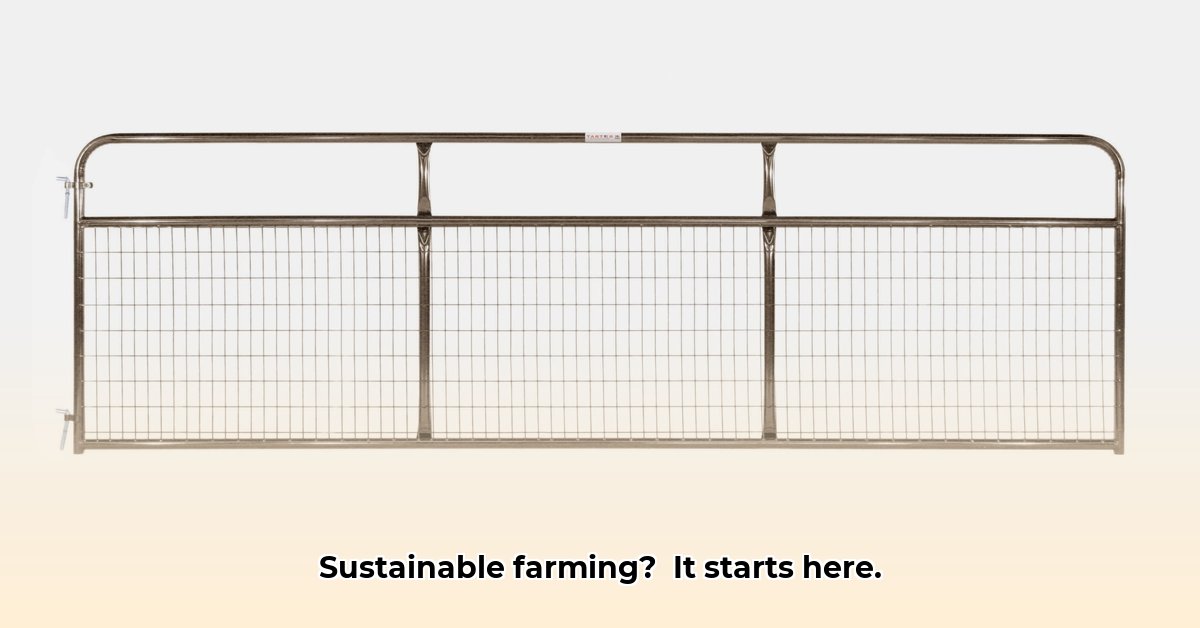
Building a sustainable farm requires careful consideration of every detail, including seemingly small aspects like fencing. Choosing the right gate can significantly impact your farm's efficiency, longevity, and environmental footprint. This guide focuses on selecting and installing a durable, cost-effective, and environmentally responsible 14-foot gate from Tractor Supply, empowering you to build a thriving and sustainable operation. For more gate options, check out these Tractor Supply gate wheels.
Choosing the Right 14-Foot Gate: Balancing Durability and Sustainability
Selecting a 14-foot gate involves weighing durability against environmental impact. Two popular choices are steel and wood, each offering distinct advantages and disadvantages. Steel gates, known for their strength and longevity, can withstand harsh weather and accidental impacts. However, their manufacturing process can have an environmental impact. Opting for gates made from recycled steel minimizes this, reducing the demand for newly produced steel and promoting a circular economy.
Wood gates, on the other hand, offer a natural aesthetic that blends with the landscape. Using locally sourced, sustainably harvested wood further reduces your carbon footprint by minimizing transportation distance and supporting local businesses. However, wood necessitates regular maintenance—painting or staining—to protect it from the elements and maximize its lifespan. Isn't it fascinating how a simple gate choice can impact your farm's sustainability?
| Material | Advantages | Disadvantages | Sustainable Considerations |
|---|---|---|---|
| Steel | Extremely strong and durable; long lifespan; low maintenance | Higher initial cost; potential environmental impact if not recycled | Prioritize recycled steel; powder-coating reduces maintenance and paint use |
| Wood | Renewable resource; aesthetically pleasing; potentially less expensive initially | Requires regular maintenance (painting, staining); shorter lifespan than steel | Choose locally sourced, sustainably harvested wood; consider treated lumber for extended life. |
Installing Your 14-Foot Gate: A Step-by-Step Guide
Correct installation is crucial for a gate's longevity. Follow these steps for a successful installation:
Prepare the Area: Clear away debris, weeds, and rocks. Ensure the ground is level to prevent future problems. A level base significantly increases gate stability and longevity.
Set the Posts: Use strong, sturdy posts firmly set in concrete. Dig deep, ensuring the posts are deeply embedded for optimal stability. This step is critical for long-term gate performance and safety.
Hang the Gate: Carefully hang the gate using the provided hinges. Ensure the gate hangs straight and level. Precise alignment prevents premature wear and improves operational efficiency.
Attach the Latch: Securely install a latch—consider a self-closing latch for added convenience and security. A properly functioning latch safeguards your livestock and property.
Final Inspection: Thoroughly inspect your work. Open and close the gate to ensure smooth operation and sturdiness. This final step safeguards against potential safety hazards and ensures continued efficient operation.
Building a Truly Sustainable Farm: The Broader Context
Choosing a sustainable gate is just one aspect of building a truly eco-friendly farm. Consider these additional practices:
Smart Grazing: Efficient grazing methods prevent overgrazing and soil erosion, leading to healthier pastures and a reduced environmental impact. Proper grazing management contributes significantly to overall land health.
Water Conservation: Implement efficient irrigation methods like drip irrigation to conserve water. Water-efficient irrigation significantly reduces environmental impact and resource consumption.
Soil Health: Employ regenerative agricultural practices, such as cover cropping and no-till farming, to enhance soil health. Healthy soil is the foundation of sustainable agriculture.
Investing in a high-quality 14-foot gate from Tractor Supply is a step towards building a durable and sustainable farm. Remember, a sustainable farm is a continuous journey, and every thoughtful decision contributes to its long-term success.
How to Choose Sustainable Fencing Materials for Eco-Friendly Farming
Sustainable fencing practices are essential for environmentally responsible farming. Material selection significantly impacts your farm's sustainability and longevity. Let’s explore sustainable fencing options to optimize your farm's eco-friendliness.
Selecting the Right Fencing Material
Before selecting materials, consider various factors:
- Livestock Needs: Different animals require different fencing strength and height. Goats need stronger fencing than sheep.
- Terrain: Hillside farms require different solutions than flat fields. Steep slopes necessitate robust materials preventing erosion.
- Climate: Extreme weather conditions demand durability and resilience in your chosen material.
- Budget: While sustainable options often offer better long-term value, they may require higher upfront investment.
Sustainable Fencing Material Options
Multiple sustainable alternatives exist:
Living Fences: Offer natural habitat, erosion control, and aesthetic appeal, but require time to establish.
Recycled Plastic: Durable, long-lasting, and environmentally friendly due to its recycled content, but can be initially more expensive.
Reclaimed Wood: Aesthetically pleasing and relatively affordable, but requires proper treatment to prevent decay.
Bamboo: A fast-growing, renewable resource, but requires maintenance to ensure longevity.
Hemp Fiber Composites: A newer, sustainable, and biodegradable option, but may be less established and potentially more expensive.
Choosing the Right Material: A Step-by-Step Guide
Assess Needs: Identify your fencing needs (livestock containment, wildlife protection, property lines).
Research Regulations: Understand local zoning and environmental regulations.
Compare Materials: Weigh the pros and cons based on your needs and budget.
Consider Long-Term Costs: Sustainability often involves higher initial costs, but lower overall lifetime expenses.
Source Responsibly: Choose suppliers committed to sustainable practices.
Proper Installation: Correct installation ensures longevity and effectiveness.
Key Takeaways:
- Prioritize environmentally friendly materials.
- Consider the material's lifespan.
- Factor in maintenance requirements.
- Check local regulations.
- Consider aesthetic appeal.
- Source materials responsibly.